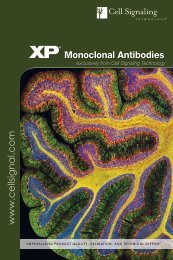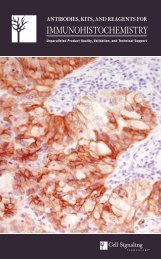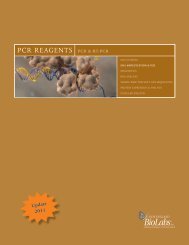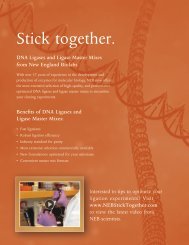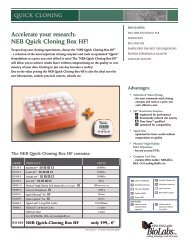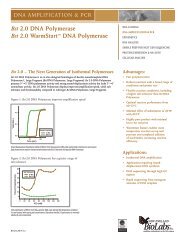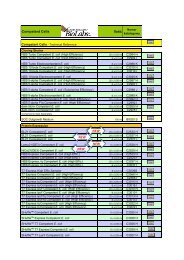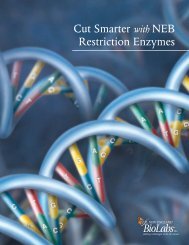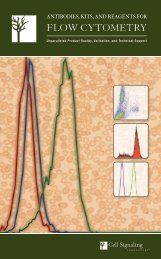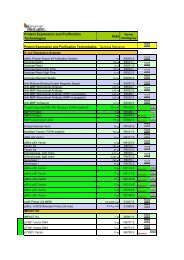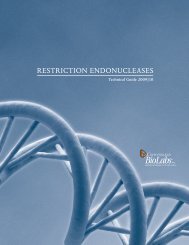IF_2012 - 7-2012.pdf - Lab-JOT
IF_2012 - 7-2012.pdf - Lab-JOT
IF_2012 - 7-2012.pdf - Lab-JOT
Create successful ePaper yourself
Turn your PDF publications into a flip-book with our unique Google optimized e-Paper software.
Translational Control<br />
Applications<br />
Reactivity<br />
#2855 Phospho-4E-BP1 (Thr37/46) (236B4) Rabbit mAb W, IHC-P, <strong>IF</strong>-IC, F H, M, R, Mk,<br />
Dm<br />
#9644 4E-BP1 (53H11) Rabbit mAb W, IP, IHC-P, H, M, R, Mk<br />
<strong>IF</strong>-IC, F<br />
#2119 BRF1/2 Antibody W, <strong>IF</strong>-IC, F H, M, R, Mk,<br />
(C, B)<br />
#2679 Calnexin (C5C9) Rabbit mAb W, IHC-P, <strong>IF</strong>-IC H, Mk<br />
#2433 Calnexin Antibody W, IHC-P, <strong>IF</strong>-IC H<br />
#3256 CLK3 Antibody W, <strong>IF</strong>-IC H, M, R, Mk<br />
New #9877 DDX5 (D15E10) XP ® Rabbit mAb W, IP, <strong>IF</strong>-IC H, M, R, Mk, (B)<br />
DDX5 (D15E10) XP ® Rabbit mAb #9877: Confocal<br />
<strong>IF</strong> analysis of HeLa cells using #9877 (green). Actin<br />
filaments were labeled with DY-554 phalloidin (red). Blue<br />
pseudocolor = DRAQ5 ® #4084 (fluorescent DNA dye).<br />
hnRNP A0 (D8A3) XP ® Rabbit mAb #5545: Confocal<br />
<strong>IF</strong> analysis of HeLa cells using #5545 (green). Actin<br />
filaments were labeled with DY-554 phalloidin (red).<br />
Product References:<br />
#2332 eEF2 Antibody: Kimball , S. R. et al. (2003)<br />
Mammalian stress granules represent sites of accumulation<br />
of stalled translation initiation complexes. Am. J. Physiol.<br />
Cell Physiol. 284, 273-284.<br />
#9407 DDX6/RCK Antibody W, <strong>IF</strong>-IC, F H, M, R, Mk<br />
#2548 EDC4/Ge-1 Antibody W, IP, <strong>IF</strong>-IC H, M, Mk<br />
#2551 eEF1A Antibody W, <strong>IF</strong>-IC H, M, R, Mk<br />
#2332 eEF2 Antibody W, <strong>IF</strong>-IC H, M, R, Mk,<br />
Dm, (Hm, C)<br />
#3692 eEF2k Antibody W, IP, <strong>IF</strong>-IC H, R, Mk<br />
#3411 e<strong>IF</strong>3A (D51F4) XP ® Rabbit mAb W, IP, IHC-P, <strong>IF</strong>-IC H, M, R, Mk<br />
#2538 e<strong>IF</strong>3A Antibody W, IP, <strong>IF</strong>-IC H, M, R, Mk<br />
#3413 e<strong>IF</strong>3H (D9C1) XP ® Rabbit mAb W, IP, IHC-P, <strong>IF</strong>-IC H, M, R, Mk<br />
#2490 e<strong>IF</strong>4A1 Antibody W, <strong>IF</strong>-IC H, M, R, Mk<br />
#5399 Phospho-e<strong>IF</strong>4B (Ser406) Antibody W, IP, <strong>IF</strong>-IC H, M, (R)<br />
#2441 Phospho-e<strong>IF</strong>4G (Ser1108) Antibody W, IP, <strong>IF</strong>-IC H, M, R, Hm,<br />
Mk, B<br />
#2469 e<strong>IF</strong>4G (C45A4) Rabbit mAb W, IHC-P, <strong>IF</strong>-IC, F H, M, R, Mk<br />
#2498 e<strong>IF</strong>4G Antibody W, IHC-P, <strong>IF</strong>-IC, F H, M, R, Mk<br />
#2858 e<strong>IF</strong>4GI Antibody W, IHC-P, <strong>IF</strong>-IC H, M, R<br />
#5169 e<strong>IF</strong>4G2/p97 (D88B6) XP ® Rabbit mAb W, IP, <strong>IF</strong>-IC, F H, M, R, Mk<br />
#3469 e<strong>IF</strong>4H (D85F2) XP ® Rabbit mAb W, IP, <strong>IF</strong>-IC H, M, R, Mk<br />
#2444 e<strong>IF</strong>4H Antibody W, <strong>IF</strong>-IC H, M, R, Mk<br />
#3833 e<strong>IF</strong>6 (D16E9) XP ® Rabbit mAb W, IP, <strong>IF</strong>-IC H, M, R, Mk<br />
#3263 e<strong>IF</strong>6 Antibody W, IP, IHC-P, <strong>IF</strong>-IC H, M, R<br />
#5033 ERp72 (D70D12) XP ® Rabbit mAb W, <strong>IF</strong>-IC, F H, M, R, Mk<br />
New #7104 FMRP (D14F4) Rabbit mAb W, <strong>IF</strong>-IC H, M, R, Mk<br />
#4317 FMRP Antibody W, IP, <strong>IF</strong>-IC H, M, R, Mk<br />
New #7098 FXR2 (D85D6) Rabbit mAb W, <strong>IF</strong>-IC H, M, R, Mk<br />
#3593 Grp75 (D13H4) XP ® Rabbit mAb W, IP, IHC-P, <strong>IF</strong>-IC H, M, Mk<br />
#2816 Grp75 Antibody W, <strong>IF</strong>-IC H, M, R, Mk<br />
Fragile X<br />
Fragile X syndrome, which research literature has shown to be a frequent cause of<br />
inherited mental retardation, often results from expansion of the CGG trinucleotide<br />
repeat in the gene that encodes the Fragile X mental retardation protein (FMRP). 1 FMRP<br />
(also known as FMR1) and its two autosomal homologs (FXR1 and FXR2) all bind RNA<br />
and play a role in the pathogenesis of Fragile X syndrome. In addition, these related<br />
proteins can associate with one another and form homodimers. FMRP can act as a<br />
translation regulator and is a component of RNAi effector complexes (RISC), suggesting<br />
a role in gene silencing. In Drosophila, dFMRP associates with Argonaute 2 (Ago2) and<br />
Dicer and coimmunoprecipitates with miRNA and siRNA. These results suggest that<br />
Fragile X syndrome is related to abnormal translation caused by a defect in RNAi-related<br />
pathways. In addition, FMRP, FXR1, and FXR2 are components of stress granules (SG)<br />
and have been implicated in the translational regulation of mRNAs.<br />
1<br />
Verkerk, A.J. et al. (1991) Cell 65, 905-914.<br />
FMRP Antibody #4317: Confocal <strong>IF</strong> analysis of C2C12 cells, untreated (upper) or<br />
MG-132-treated (10 μg/mL, 3 hr; lower), using #4317 (green). Actin filaments<br />
were labeled with DY-554 phalloidin (red). Blue pseudocolor = DRAQ5 ® #4084<br />
(fluorescent DNA dye).<br />
28 Application and Reactivity Keys, pg 3. Monoclonal Antibody. Please see page 2 for details.



